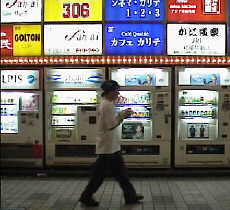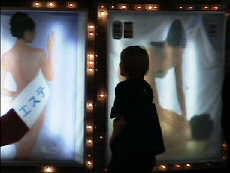June 15-21
Tokyo, Kyoto & Nara, Part III


Ubiquitous rows of vending machines.
![]()
![]()
In this story:
Strange Mix of Contradictions
Final Thoughts
Strange Mix of Contradictions
While most of China and other parts of Asia seemed so survivalist (mostly from necessity), post-modern Japan (and especially Tokyo) seemed a little lost for its soul – almost mournful, too fast, too consumed. Tokyo seemed a strange mix of contradictions in style and substance.
First, although generally everything was pretty expensive, there were other things that were surprisingly inexpensive. Taxis, restaurants, clothes, internet were expensive, yet trains, tailored custom suits, and some leather goods were actually not that expensive. And while my first attempt to eat shabu shabu cost about $80, I found another place in the middle of Shinjuku that had shabu shabu for $12 – and all you could eat for $23!
Second, there were the conservative-looking businessmen in dark suits and briefcases, docile and subservient geisha, the wild-looking young teenage girls with fishnet stockings, short skirts and orange hair, schoolchildren in their blue and white uniforms, the “hello kitties” and cute anime characters everywhere – were they illusions or realities of a deeper culture?


Adult advertisements in Kabukicho.
![]()
![]()
It was as late as 1853 that Japan was forcibly opened to foreigners by an American Navy fleet, and Japan still seemed a society of ingrained culture and tradition. While I was there, I read an interesting article (which unfortunately I can’t find now) that discussed how the social environment often made it very difficult for many modern Japanese artists to make a living at home, leading to an exodus of talent. As the artist Mariko Mori, now in New York, explained in an interview, “I was looking for freedom…. Japan is a unified society which does not allow for individualism…. In Japan people try not to behave outside of common standards. You are constantly reminded not to step out of line. I did not accept that…. I was compelled to escape as soon as possible.”
Having a unified and traditional society had many benefits, perhaps making Japan previously such a force of efficiency, mass production, and gadgetry, with social order and one of the lowest crime rates in the world. But having such a conservative society also contributed to its inability to combat corruption or to reform its own economy to a changing world, and its having one of the world’s highest suicide rates. Conceptually, I could understand a societal choice for traditional conservatism and unity.
What I didn’t understand was how you could have such a conservative conformist society that also seemed to value and accept the kawaii culture as well. “Kawaii” means cute – little school girl uniforms, puffy leg warmers, pig tails, and “hello kitty”. Kawaii was lolita pop – like kahimi kari, who I had seen in New York singing in a childish voice that sounded regressively blissful. But kawaii also seemed to mean fishnet stockings, short skirts, orange hair, and a certain outward adolescent sexuality. School girls were acceptable, and docile and cute were acceptable. But what about the sexual fetishism that seemed a darker yet accepted part of kawaii?
How did you explain a society that was allegedly the world’s main source of child pornography; where massage parlors and love hotels seemed everywhere (even in less urban areas); where adult films were everywhere advertised featuring girls in school uniforms, kinky S&M, and being tied up; where a small but significant percentage of school girls had a practice of part-time prostitution for spending money (a practice called enjo kosai, or “compensated dating”); and where stores and vending machines trafficked in little girls’ soiled underwear! I only realized about half of that while I was there. Only after returning and speaking to friends about this entry (who were Japanese, had lived in Japan, or were Asia-philes), did I start to realize the full scale of these practices – perhaps still a minority, but meaningfully significant.
When I asked these friends how such a conservative society could also seem to be so accepting of the full extent of the kawaii culture, I got a mix of not-too-conclusive answers. A few had answers that together made sense – that perhaps the socially authoritarian environment effected a culture of submission, but also a culture of insecurity, fear of expression, and sexual inferiority. The token submission of some (young girls) together with the inferiority complexes of others (conservative older men) led to this strange arrangement of convenience. As a Time magazine article argued, “The common explanation for Japan’s tolerance of child porn is that the country is run by a clique of old men with little sensitivity toward women and children…. [but] There’s another theory for the obsession with pedophilia: that Japanese men feel threatened by adult women. ‘Many men are incapable of relating to adult women on an equal stance.'”
The conservative social environment meant that the crime rate was one of the world’s lowest. But it also meant that some of the most popular new phones were those that would ring with cute anime graphics that would tell you “Gambatte kudasai!”, meaning “Keep your chin up!”.
It was an environment that hindered even its men from being individually assertive, that made them afraid of their peers and their own sexual performance. An environment that made it acceptable to be a cute school girl, to accept authority, and yet also to be precociously sexual and powerful. An environment (despite makeshift romantic meeting places like the make-out deck above Shinjuku station), where lack of personal space or living with one’s parents, led to an overwhelming demand for love hotels – which also made it incredibly easy for anyone to make secret rendezvous. And finally, an environment that compelled its youth to rebelliously invent their identities, seemingly apart from a conservative veneer, but necessarily within that same conservative context.
While there, I felt like I was only seeing the tip of the iceberg. And I was. Now, I felt like I was getting it a little. I really needed a guide and interpreter. A few months would probably not have been enough. I think you had to speak the language, or you had to be Japanese to be able to really feel and understand it all.


A bridge and misty hills over the Kamo River in Kyoto.
![]()
![]()
Final Thoughts
Despite my inability to fully grasp the seeming social contradictions and conservative mindset, there was so much that I loved about Japan – Japanese gadgets, Japanese food, Japanese service, Japanese movies and anime, the Japanese aesthetic.
At Isetan, I had the privilege of meeting the woodblock print master Munenori Makino and his daughter Fuurinmaru. Together they had a body of work that was beautiful in its apparent simplicity, even though I realized how much work went into even just one of their prints (including some 15-30 individually carved blocks and colors).
Most of my time in Japan, there was rain, rain, and more rain. Umbrellas were everywhere – umbrella signs, umbrella stands, and even plastic umbrella bag dispensers (to keep the wetness inside). But I liked rain. and it helped to frame that beautiful sense of mournfulness that I felt. Just like the inexpensive hotel where I was staying. The walls were not too thick, and one night the couple in the next room over were really getting it on.
My only regret was that I wasn’t able to go to the all night trance clubs and discos of Roppongi. Too far away and expensive to come back by taxi, and I was much too tired to try and stay out all night. But with everything else I saw and experienced, I was content to appreciate the aesthetic beauty that was everywhere and uniquely Japan.
For tons more pictures of Paul’s time in Japan and the rest of his Asia Journal, go to his web site.